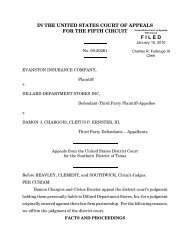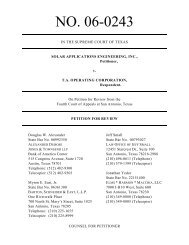Case: 09-10622 Document: 00511064454 Page: 12 Date Filed: 03/29/2010No. 09-10622On appeal, the Ninth Circuit noted that, while the question “[w]hether aparticular action constitutes a ‘transfer’ is a matter of federal law,” “a ‘transfer’cannot occur without ‘property’ or ‘an interest in property’” and that “in theabsence of any controlling federal law, ‘property’ and ‘interests in property’ arecreatures of state law.” Id. at 793 (internal quotation marks, modifications, andcitations omitted). <strong>The</strong>n, in looking to Arizona law, the Ninth Circuitdetermined that Arizona treated a disclaimer as relating back to the date ofdeath of the decedent. Id. at 793–94. Similarly to Texas and Arkansas lawdiscussed above, the effect of such a transfer was that the “disclaimant [istreated as] neither transfer[ring] nor possess[ing] an interest in disclaimedproperty . . . .” Id. at 794. <strong>The</strong> Ninth Circuit then looked to cases post-Butnerand concluded that “[t]hough most courts have found that Butner principlespreclude avoidance of disclaimers under § 548, this line of authority has beenthrown into doubt by Drye[.]” Id.Specifically, the trustee urged that the Ninth Circuit “extend Drye to thebankruptcy context and recognize the ‘right to channel’ as an ‘interest . . . inproperty’ for purposes of the [bankruptcy c]ode.” Id. at 795. However, the courtrejected such an extension, holding “that Drye is distinguishable, both factuallyand legally, and that its adoption in the bankruptcy context would, in any event,be inappropriate.” Id. First, the Ninth Circuit determined that Drye is factuallydistinguishable, noting that the tax lien in Drye was already operative before thedisclaimer, while in Costas, the disclaimer occurred before the bankruptcypetition. Id. at 795–96. Second, the court held that Drye is legallydistinguishable, concluding that the Court’s repeated reference to the scope ofthe question presented in Drye suggested it was limited solely to the tax liencontext. On this point, the Ninth Circuit recounted how the Court had“repeatedly construed tax lien provisions to permit the government to reachproperty beyond the grasp of other creditors.” Id. at 796 (citing references).12
Case: 09-10622 Document: 00511064454 Page: 13 Date Filed: 03/29/2010No. 09-10622Finally, the court noted that the scope of exemptions under the bankruptcy codeis significantly broader than the exemptions allowed under the IRC andconcluded that this “highlights the key difference between ‘property’ for purposesof tax collection and for bankruptcy: the former largely trumps state law, theother tries to incorporate it.” Id. at 797. 94. ConclusionWe find the reasoning of Costas persuasive, and we hold that Butner’sdeferential approach to state property law, rather than the rule of Drye, controlswhen determining whether a debtor has transferred “property” or “interests inproperty” by executing a pre-petition disclaimer under § 727(a)(2). <strong>The</strong> NinthCircuit’s reasoning is sound: the bankruptcy code defines “transfer,” but to effecta transfer there must be “property” or an “interest in property.” And theSupreme Court has repeatedly held that “[p]roperty interests are created anddefined by state law” in the absence of a controlling federal interest. Butner, 440U.S. at 55. Drye is distinguishable here because its reasoning drew from the9In Costas, the trustee also argued that, following Butner, there was a “federalinterest” exemption that should preclude state law deference. Specifically, the trustee arguedthat (1) there was a federal interest in bankruptcy estate augmentation and that (2) § 548created a federal rule of avoidance. Id. at 798. <strong>The</strong> Ninth Circuit rejected these arguments,determining that as to (1) “such a generic interest in expanding the debtor’s property would. . . interfere with Butner’s three goals of avoiding uncertainty, forum shopping, and windfallrecoveries,” and thus the interest was insufficient; and as to (2) there was nothing in § 548that suggested a deviation from Butner, when Congress had used the generic terms “property”or “interest in property” as it had in other sections of the bankruptcy code. Id. at 795–98Accordingly, the Ninth Circuit “[a]ppl[ied] Butner’s deferential approach to state law, ratherthan the rule of Drye[, held that] a disclaimer, properly executed under Arizona law, does notqualify as the ‘transfer . . . of an interest of the debtor in property’ for purposes of § 548,” andaffirmed the B.A.P. Id. at 798.<strong>Nouveau</strong> does not specifically urge that a comparable “federal interest” supersedesdeference to state law conceptions of property under Butner, but instead argues generally that“[t]he Bankruptcy Code is a purely federal law creature” and that “discharge” is an issue offederal law. However, to the extent that <strong>Nouveau</strong>’s argument presents a superseding federalinterest, we find the Ninth Circuit’s reasoning persuasive, and we decline to hold that thegeneric “federal interests” in bankruptcy or discharge preclude deference to state property lawhere.13




